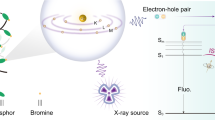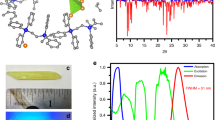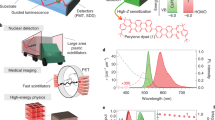Abstract
Materials that exhibit X-ray-excited luminescence have great potential in radiation detection, security inspection, biomedical applications and X-ray astronomy1,2,3,4,5. However, high-performance materials are almost exclusively limited to ceramic scintillators, which are typically prepared under high temperatures6. Herein we report metal-free organic phosphors based on a molecular design that supports efficient triplet exciton harvesting to enhance radioluminescence. These organic scintillators exhibit a detection limit of 33 nGy s–1, which is 167 times lower than the standard dosage for X-ray medical examination and we demonstrate their potential application in X-ray radiography. These findings provide a fundamental design principle and new route for the creation of promising alternatives to incumbent inorganic scintillators. Furthermore, they offer new opportunities for development of flexible, stretchable X-ray detectors and imagers for non-destructive radiography testing and medical imaging.
This is a preview of subscription content, access via your institution
Access options
Access Nature and 54 other Nature Portfolio journals
Get Nature+, our best-value online-access subscription
$29.99 / 30 days
cancel any time
Subscribe to this journal
Receive 12 print issues and online access
$209.00 per year
only $17.42 per issue
Buy this article
- Purchase on Springer Link
- Instant access to full article PDF
Prices may be subject to local taxes which are calculated during checkout




Similar content being viewed by others
Data availability
The data that support the plots within this paper and other findings of this study are available from the corresponding author on reasonable request. Source data are provided with this paper.
References
Büchele, P. et al. X-ray imaging with scintillator-sensitized hybrid organic photodetectors. Nat. Photon. 9, 843–848 (2015).
Chen, Q. et al. All-inorganic perovskite nanocrystal scintillators. Nature 561, 88–93 (2018).
Yang, Y. et al. X-ray-activated long persistent phosphors featuring strong UVC afterglow emissions. Light Sci. Appl. 7, 88 (2018).
Fan, W. et al. Breaking the depth dependence by nanotechnology-enhanced X-ray-excited deep cancer theranostics. Adv. Mater. 31, 1806381 (2019).
Gandini, M. et al. Efficient, fast and reabsorption-free perovskite nanocrystal-based sensitized plastic scintillators. Nat. Nanotechnol. 15, 462–468 (2020).
Weber, M. J. Inorganic scintillators: today and tomorrow. J. Lumin. 100, 35–45 (2002).
Kim, Y. C. et al. Printable organometallic perovskite enables large-area, low-dose X-ray imaging. Nature 550, 87–91 (2017).
Shrestha, S. et al. High-performance direct conversion X-ray detectors based on sintered hybrid lead triiodide perovskite wafers. Nat. Photon. 11, 436–440 (2017).
Pan, W. et al. Cs2AgBiBr6 single-crystal X-ray detectors with a low detection limit. Nat. Photon. 11, 726–732 (2017).
Lu, K. et al. Low-dose X-ray radiotherapy–radiodynamic therapy via nanoscale metal–organic frameworks enhances checkpoint blockade immunotherapy. Nat. Biomed. Eng. 2, 600–610 (2018).
Nikl, M. & Yoshikawa, A. Recent R&D trends in inorganic single-crystal scintillator materials for radiation detection. Adv. Optical Mater 3, 463–481 (2015).
Lusic, H. & Grinstaff, M. W. X-ray-computed tomography contrast agents. Chem. Rev. 113, 1641–1666 (2012).
Hajagos, T., Liu, C., Cherepy, N. & Pei, Q. High-Z sensitized plastic scintillators: a review. Adv. Mater. 30, 1706956 (2018).
Chen, X., Song, J., Chen, X. & Yang, H. X-ray-activated nanosystems for theranostic applications. Chem. Soc. Rev. 48, 3073–3101 (2019).
Baldo, M. A., Thompson, M. E. & Forrest, S. R. High-efficiency fluorescent organic light-emitting devices using a phosphorescent sensitizer. Nature 403, 750–753 (2000).
Rao, A. et al. The role of spin in the kinetic control of recombination in organic photovoltaics. Nature 500, 435–439 (2013).
Thompson, N. J. et al. Energy harvesting of non-emissive triplet excitons in tetracene by emissive PbS nanocrystals. Nat. Mater. 13, 1039–1043 (2014).
Zhang, G., Palmer, G., Dewhirst, M. & Fraser, C. A dual-emissive-materials design concept enables tumour hypoxia imaging. Nat. Mater. 8, 747–751 (2009).
Yuan, W. et al. Crystallization-induced phosphorescence of pure organic luminogens at room temperature. J. Phys. Chem. C 114, 6090–6099 (2010).
An, Z. et al. Stabilizing triplet excited states for ultralong organic phosphorescence. Nat. Mater. 14, 685–690 (2015).
Yang, Z. et al. Intermolecular electronic coupling of organic units for efficient persistent room-temperature phosphorescence. Angew. Chem. Int. Ed. 55, 2181–2185 (2016).
Lucenti, E. et al. Cyclic triimidazole derivatives: intriguing examples of multiple emissions and ultralong phosphorescence at room temperature. Angew. Chem. Int. Ed. 56, 16302–16307 (2017).
Xie, Y. et al. How the molecular packing affects the room temperature phosphorescence in pure organic compounds: ingenious molecular design, detailed crystal analysis, and rational theoretical calculations. Adv. Mater. 29, 1606829 (2017).
Wang, J. et al. A facile strategy for realizing room temperature phosphorescence and single molecule white light emission. Nat. Commun. 9, 2963 (2018).
Su, Y. et al. Ultralong room temperature phosphorescence from amorphous organic materials toward confidential information encryption and decryption. Sci. Adv. 4, 9732–9744 (2018).
Salla, C. A. et al. Persistent solid-state phosphorescence and delayed fluorescence at room temperature by a twisted hydrocarbon. Angew. Chem. Int. Ed. 58, 6982–6986 (2019).
Ma, H., Peng, Q., An, Z., Huang, W. & Shuai, Z. Efficient and long-lived room-temperature organic phosphorescence: theoretical descriptors for molecular designs. J. Am. Chem. Soc. 141, 1010–1015 (2019).
Wang, W., Zhang, Y. & Jin, W. Halogen bonding in room-temperature phosphorescent materials. Coord. Chem. Rev. 404, 213107 (2020).
Li, W. et al. Selective expression of chromophores in a single molecule: soft organic crystals exhibiting full-colour tunability and dynamic triplet–exciton behaviours. Angew. Chem. Int. Ed. 59, 3739–3745 (2020).
Baryshnikov, G., Minaev, B. & Ågren, H. Theory and calculation of the phosphorescence phenomenon. Chem. Rev. 117, 6500–6537 (2017).
Bolton, O., Lee, K., Kim, H., Lin, K. & Kim, J. Activating efficient phosphorescence from purely organic materials by crystal design. Nat. Chem. 3, 205–210 (2011).
Gu, L. et al. Colour-tunable ultra-long organic phosphorescence of a single-component molecular crystal. Nat. Photon. 13, 406–411 (2019).
Zhang, T. et al. Molecular engineering for metal-free amorphous materials with room-temperature phosphorescence. Angew. Chem. Int. Ed. 59, 11206–11216 (2020).
El-Sayed, M. A. Triplet state: its radiative and nonradiative properties. Acc. Chem. Res. 1, 8–16 (1968).
Wei, H. et al. Sensitive X-ray detectors made of methylammonium lead tribromide perovskite single crystals. Nat. Photon. 10, 333–339 (2016).
Zhuang, R. et al. Highly sensitive X-ray detector made of layered perovskite-like (NH4)3Bi2I9 single crystal with anisotropic response. Nat. Photon. 13, 602–608 (2019).
Long, G. & Winefordner, J. Limit of detection: a closer look at the IUPAC definition. Anal. Chem. 55, 712A–724A (1983).
Berger, M. J. et al. XCOM: Photon Cross Sections Database (National Institute of Standards and Technology, 2013); https://www.nist.gov/pml/xcom-photon-cross-sections-database
Acknowledgements
This work is supported by the National Key R&D Program of China (grant no. 2020YFA0709900), the National Natural Science Foundation of China (grant nos. 21975120, 21875104, 91833304, 21973043, 51673095 and 61935017), the Joint Research Funds of Department of Science and Technology of Shaanxi Province and Northwestern Polytechnical University (grant no. 2020GXLH-Z-006), Natural Science Fund for Distinguished Young Scholars of Jiangsu Province (grant no. BK20180037), China National Postdoctoral Program for Innovative Talents (grant no. BX20200278), Projects of International Cooperation and Exchanges NSFC (grant no. 51811530018), the Fundamental Research Funds for the Central Universities, Agency for Science, Technology and Research (A*STAR) under its AME program (grant nos. A1883c0011 and A1983c0038), and the King Abdullah University of Science and Technology (KAUST) Office of Sponsored Research (OSR) under award no. OSR-2018-CRG7-3736.
Author information
Authors and Affiliations
Contributions
X.W., H.S., Z.A., X.L and W.H. conceived the experiments. X.W., H.S., Z.A., X.L. and W.H. prepared the paper. X.W., H.S., W.Y., L.S., X.Y., G.Y, Z.Z., M.S., C.L., J.Z. and C.D. were primarily responsible for the experiments. J.Z., X.O., Y.T., Q.C., Y.W. and H.Y. were responsible for the X-ray related experiments. H.W., Q.W. and W.J. performed lifetime and quantum yield measurements. H.M. and X.J. contributed to time-dependent density functional theory calculations calculations. Y(M).Y. conducted photoconductive gain measurements. X.X., J.W., Q.C. and G.Z. gave suggestions of conceptual ideas and language improvements for the manuscript. All authors contributed to the data analyses.
Corresponding authors
Ethics declarations
Competing interests
The authors declare no competing interests.
Additional information
Peer review information Nature Photonics thanks the anonymous reviewers for their contribution to the peer review of this work.
Publisher’s note Springer Nature remains neutral with regard to jurisdictional claims in published maps and institutional affiliations.
Supplementary information
Supplementary Information
Supplementary Figs. 1–12, Tables 1–5, Equations 1–10, Scheme 1 and references.
Crystallographic Data 1
The crystallographic data of o-ITC.
Crystallographic Data 2
The crystallographic data of m-ITC.
Crystallographic Data 3
The crystallographic data of p-ITC.
Source data
Source Data Fig. 2
Numerical data used to generate Fig. 2.
Source Data Fig. 3
Numerical data used to generate Fig. 3.
Source Data Fig. 4
Numerical data used to generate Fig. 4.
Rights and permissions
About this article
Cite this article
Wang, X., Shi, H., Ma, H. et al. Organic phosphors with bright triplet excitons for efficient X-ray-excited luminescence. Nat. Photonics 15, 187–192 (2021). https://doi.org/10.1038/s41566-020-00744-0
Received:
Accepted:
Published:
Issue Date:
DOI: https://doi.org/10.1038/s41566-020-00744-0
This article is cited by
-
Efficient and ultrafast organic scintillators by hot exciton manipulation
Nature Photonics (2024)
-
X-ray-activated polymerization expanding the frontiers of deep-tissue hydrogel formation
Nature Communications (2024)
-
Twofold rigidity activates ultralong organic high-temperature phosphorescence
Nature Communications (2024)
-
Abnormal thermally-stimulated dynamic organic phosphorescence
Nature Communications (2024)
-
Water-dispersible X-ray scintillators enabling coating and blending with polymer materials for multiple applications
Nature Communications (2024)



